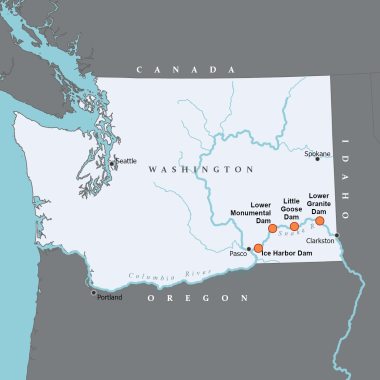Planning study news
The study is organized into four phases.
Phase 1 – Understanding Needs
Phase 2 – Impacts and Safety
Phase 3 –Competitive and Regulatory Impacts
Phase 4 – Draft and Final Report
Work for Phase 1 of the study, Understanding Needs, is nearing completion, with a status report released in December 2025 (see Comment tab below for the report). The report includes an analysis of existing goods movement conditions, existing volumes, rail and vehicular volume changes, and engagement activities to-date.
During Phase 1, the project team began collecting information from companies that create and move freight to be able to build a transportation model. The transportation model is being used throughout the study to determine how the transportation network will need to change to continue moving goods into and out of Eastern Washington.
Phase 2, Impacts and Safety will be underway in Spring 2025 and a broad public engagement effort will accompany it.
Additionally, the study team formed two advisory committees: the Technical Advisory Committee and the Community Advisory Committee. These groups meet at key milestones throughout the study to provide additional review and input for data analysis and community engagement, respectively.
Technical Advisory Committee: The Technical Advisory Committee is charged with reviewing study elements and representing their organization/agencies interests. Their primary role is to ensure that the study is using the most up to date local, regional and state data. This includes keeping agency partners informed about technical and policy work and helping the project team understand local, regional, state and tribal needs. The Technical Advisory Committee is comprised of representatives from various organizations, federal, state and local representatives, and businesses.
Community Advisory Committee: The Community Advisory Committee is charged with representing organizational and governmental interests and reviewing community engagement approaches within the study. Their primary role is to ensure that the study considers the direction of current local policy and maintains strong community engagement and outreach. This includes keeping local organizational stakeholders and government offices informed about the study and engagement opportunities, as well as helping the project team understand local, regional, state and tribal needs. The committee is comprised of representatives from various local organizations and local elected officials.
Purpose
The Snake River from Clarkston to Pasco contains four dams (Ice Harbor, Lower Monumental, Little Goose and Lower Granite). There has been much interest in removal of these dams for the benefit of salmon, steelhead, Pacific lamprey, bull trout, sturgeon and other native fish species. While there have been several studies that address the topic of removing the dams, there is limited understanding of how transportation would be affected.
As such, the Legislature (see ESHB 2134, Section 217 (9)) directed WSDOT to conduct an analysis of highway, road and freight rail transportation needs, options and impacts of shifting the movement of freight and goods that currently move by barge to truck and rail. This study will fulfill that request by the Legislature.
Upcoming engagement opportunities
To stay up-to-date, join GovDelivery and check out the public engagement calendar of events (PDF 252KB).
Quarterly reports and other resources can be found in the Outcomes tab below.

